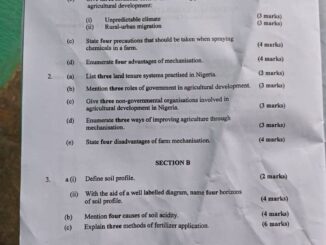Are you searching for WAEC GCE 2025 Financial Accounting answers? You’re in the right place! At Naijaclass Academy (Naijaclass.com), we provide reliable, timely, and verified WAEC GCE questions and answers to help students prepare and excel in their exams.
Our goal is simple – to make sure every student passes once and for all. With our professional tutors and real exam insight, you can be confident that you’re learning from the best.

Wednesday, 12th November, 2025
Financial Accounting 2 (Theory and Practice) – 2hrs 30mins – 08:30 hrs – 11:00 hrs.
Financial Accounting 1 (Objective) – 1hr – 11:00 hrs – 12:00 hrs.
*WAEC GCE FINANCIAL ACCOUNTING*
*NUMBER ONE*
(1ai)
Bank Statement: A bank statement is a document prepared and issued periodically by a bank to its customer, showing all transactions that have taken place in the customer’s account over a specific period. It includes deposits, withdrawals, bank charges, standing orders, and the resulting balance. It helps the account holder verify and compare the bank’s record with their own cash book.
(1aii)
Bank Reconciliation Statement: A bank reconciliation statement is a statement prepared by an organization to reconcile the difference between the cash book balance and the bank statement balance at a particular date. The differences usually arise due to unpresented cheques, uncredited lodgements, or errors made by the bank or the business. The reconciliation ensures that both records show the true cash position.
(1aiii)
Petty Cash: Petty cash is a small amount of money set aside by an organization to settle minor day-to-day expenses such as transport fares, postage, cleaning materials, and stationery. It is usually controlled under the imprest system, where a fixed amount is given to the petty cashier and replenished when the fund is exhausted, based on proper documentation.
(1b)
(i) Unpresented Cheques: These are cheques issued by the business to suppliers or creditors but have not yet been presented to the bank for payment. They cause the cash book to show a lower balance than the bank statement until presented.
(ii) Uncredited Lodgements: These are amounts deposited by the business into the bank that have not yet appeared on the bank statement. They make the cash book balance higher than the bank’s balance until the bank processes them.
(iii) Bank Charges or Errors: These include service charges, commission, or interest deducted by the bank which the business has not yet recorded, or any errors made by either party. Adjusting these helps both balances agree.
*WAEC GCE FINANCIAL ACCOUNTING*
*NUMBER TWO*
(2a)
(i) Debit Cash/Bank Account
(ii) Credit Bad Debt Recovered Account
(2b)
(PICK ANY TWO)
(i) Debtors (Accounts Receivable) Account
(ii) Provision for Bad and Doubtful Debts Account
(iii) Sales Account
(iv) Discount Allowed Account
(2c)
(PICK ANY FIVE)
(i) To record debts that are considered irrecoverable.
(ii) To show the true financial position of the business.
(iii) To prevent overstatement of assets (debtors).
(iv) To comply with the prudence concept of accounting.
(v) To determine the actual profit or loss of the period.
(vi) To track and control the amount lost through bad debts.
(vii) To separate irrecoverable debts from doubtful ones.
(viii) To provide a record for future reference and recovery purposes.
*WAEC GCE FINANCIAL ACCOUNTING*
*NUMBER THREE*
(3a)
(i) Rent and Rates: Floor area occupied by each department.
(ii) Electricity: Kilowatt-hours used by each department or number of light points.
(iii) Discount Allowed: Sales value of each department.
(iv) Carriage Outwards: Sales value or volume of goods sold by each department.
(v) Salaries and Wages: Time spent in each department or number of employees in each department.
(vi) Insurance of Building: Floor area occupied by each department.
(vii) Sales Commission: Sales value of each department.
(3b)
(i) To assess the profitability of each department.
(ii) To compare the performance of different departments.
(iii) To make informed decisions about resource allocation.
(iv) To identify areas for improvement in each department.
*WAEC GCE FINANCIAL ACCOUNTING*
*NUMBER FOUR*
4a)
(PICK ANY THREE)
(i) Statement of Financial Performance (Income and Expenditure Statement)
(ii) Statement of Financial Position (Balance Sheet)
(iii) Cash Flow Statement
(iv) Statement of Changes in Net Assets/Equity
(v) Notes to the Accounts (including Accounting Policies)
(vi) Statement of Comparison of Budget and Actual Amounts
(4b)
=Internal Users=
(i) Management (for planning, control and decision-making)
(ii) Budget officers and departmental heads
(iii) Internal auditors
=External Users=
(i) Creditors and suppliers
(ii) Tax authorities
(iii) The general public/citizens
(4c)
(PICK ANY THREE)
(i) To provide information for decision-making and policy formulation.
(ii) To ensure accountability and transparency in the use of public funds.
(iii) To show the financial position and performance of the government.
(iv) To comply with legal and regulatory requirements.
(v) To facilitate auditing and attract donor confidence or investment support.





Be the first to comment